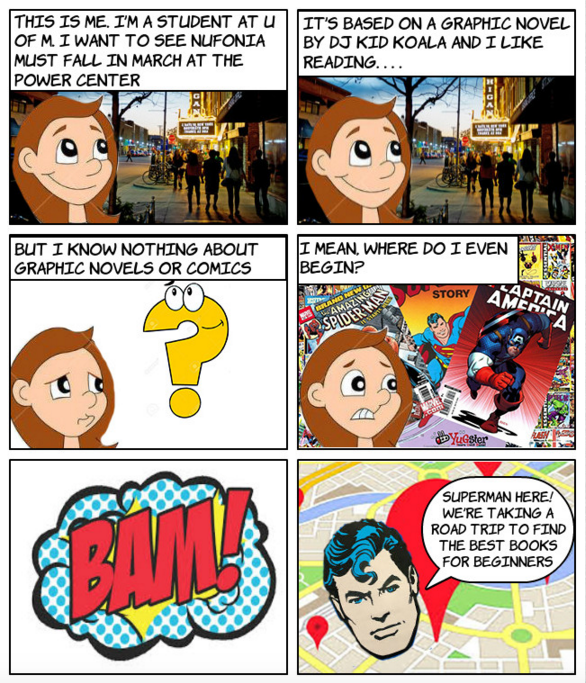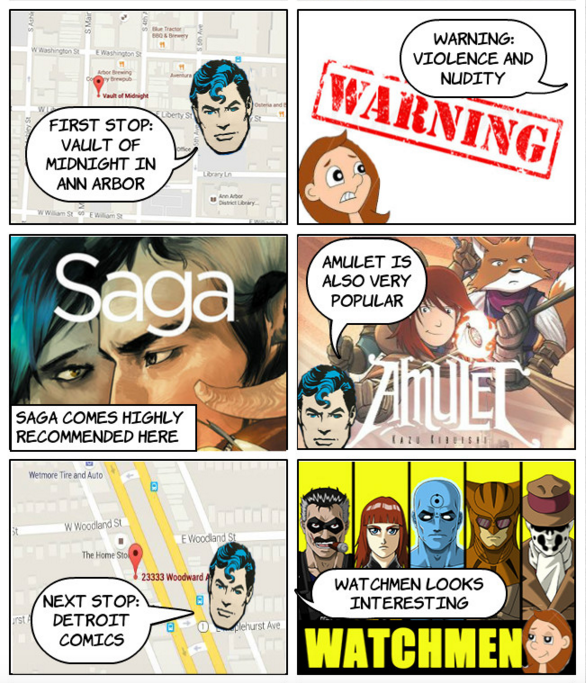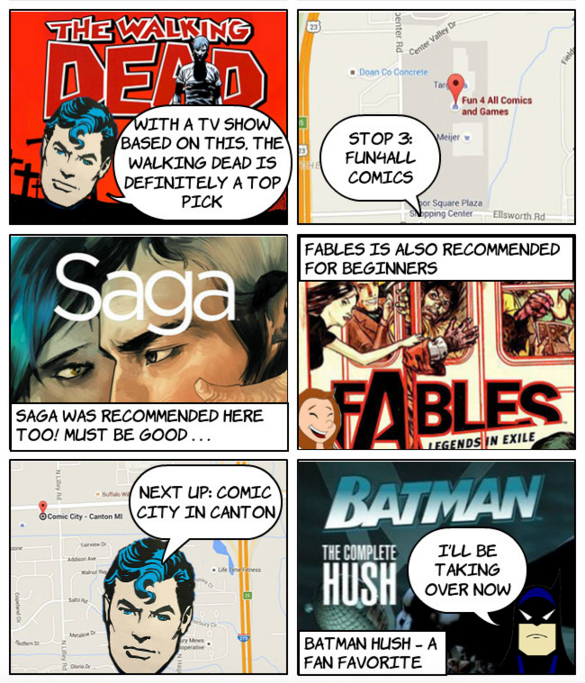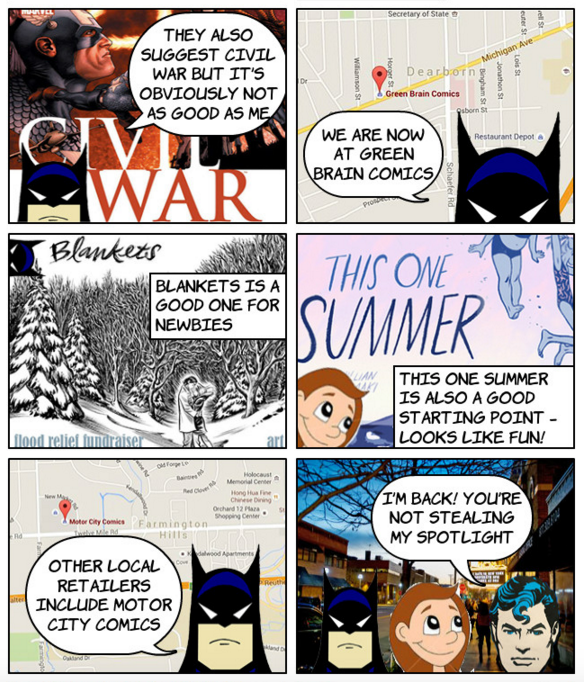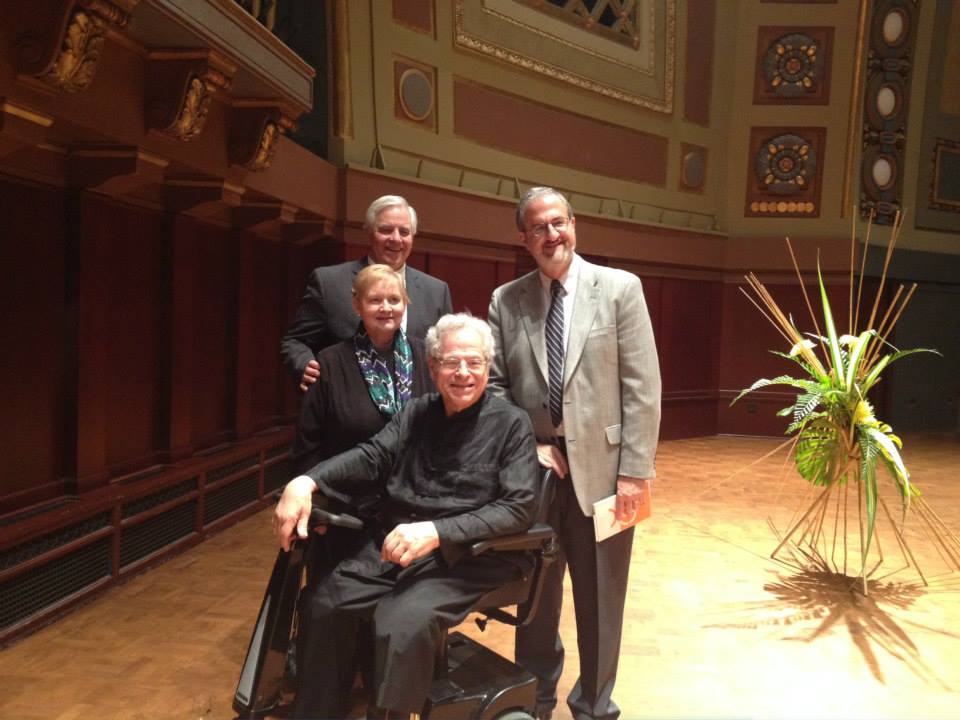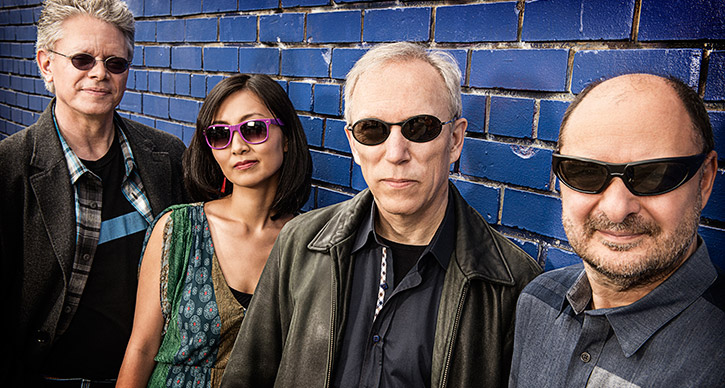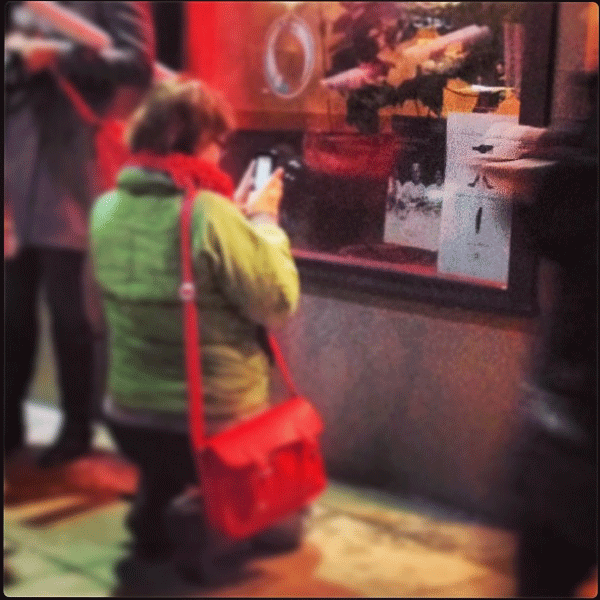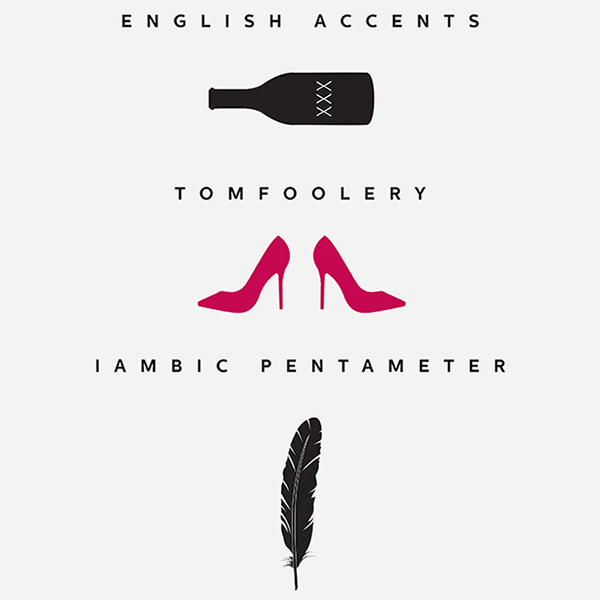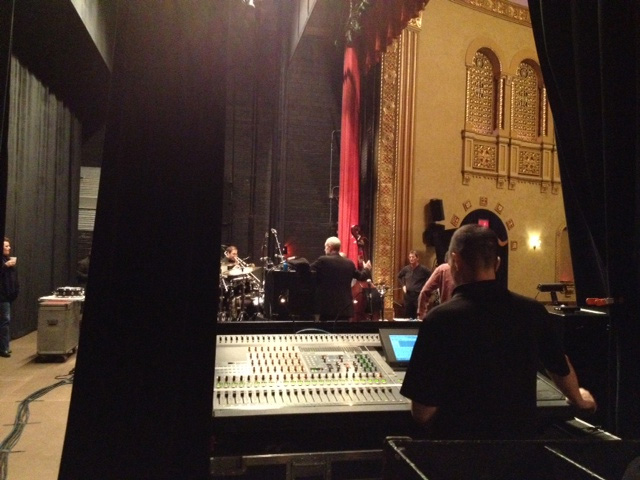Playlist: Powerful Voices

Photo: Vocal ensemble Roomful of Teeth, who perform with chamber group A Far Cry in Ann Arbor on April 12, 2017. Photo by Bonica Ayala.
My parents started me on piano and violin at a young age, so I’ve been exposed to classical music for almost all of my life. I grew up listening to Pavarotti and Andrea Bocell, and it wasn’t until later that I began exploring more modern Pop and Rock genres. Throughout the years, I’ve listened to most genres of music, including country, gospel, classic rock to name a few. But, funnily enough, I didn’t truly appreciate the human voice until I got strep in 10th grade and lost my voice for a week and a half. It was a classic case of not knowing what you have until it’s gone. The week and half of not being able to communicate with others or sing along to my favorite songs made me realize just how important and powerful our voices are.
In the playlist below, I’m collecting some examples of how we convey emotions, ideas, and beliefs through voice, whether it’s through music, spoken word, or through countless other ways we use our voices.
Whitney Houston’s National Anthem
Our national anthem is one of my favorite tunes, not only because of its beautiful melody, but also because the words have the capacity to instill a sense of pride in the foundations and values of this nation. I like this Whitney Houston rendition because of its simplicity, and yet, its power.
Spoken Word
I have always loved spoken word, the way the combination of rhythm and language creates a special kind of emotion. Here is just one example, by College National Poetry Slam champion Neil Hillborn. Joey focuses on the disparity in access to mental illness treatment and on the role that privilege plays in our mental health system.
Opera
I didn’t appreciate opera very much growing up, mostly because it was usually in another language, and I had no sense of the stories within the pieces. I’ll be honest, I still don’t know most of the time. However, as an adult, I’ve come to be able to feel the pieces even when I don’t understand the words. So, here is Pavarotti’s performance of Nessun Dorma. For this one, sit back, close your eyes, and feel the strength of his voice.
Voices and Orchestral Works
I know no better way to demonstrate the power and range of our voices than with Carmina Burana. I’m sure you’ve heard parts of this work, which has made appearances in popular culture including but not limited to college football games and commercials.
Speeches
Martin Luther King Jr.’s I have a dream speech is iconic. The timbre of his voice, its pace, amplify its incredibly potent themes. On the other hand, Robin Williams’s Make Your Life Spectacular speech is softly spoken and wistful; it drifts over as his message sinks in. These two entirely different approaches give a sense of the capacity of the voice to inspire.
Popular song, and then, something in between
Kanye West’s Say You Will, featuring the vocalist and composer Caroline Shaw, explores the sounds that the voice is capable of making in combination with technology.
I’m sure you’ve heard of Kanye West, but you may not yet know of Caroline Shaw. Caroline Shaw, a Grammy-award-winning singer, violinist, and composer. From yodeling to throat singing, Caroline Shaw and Roomful of Teeth expand the capacity of the voice across genres and singing techniques.
This great diversity in sound is showcased in the group’s performance with NPR Music’s Tiny Desk Concert, shown below. Both the artist and the group are known for continuously exploring the boundaries of the human voice, encompassing both the breadth and depth of our voices. Their works embody the impact and the amazing variety of the human voice. Your chance to check them out in person is coming up. They perform with chamber group A Far Cry in Ann Arbor on April 12, 2017.
Jae Cosmos Lee, a violinist with A Far Cry, has also been kind enough to sit down with us and answer a few questions about his work and inspirations:
A Far Cry with Roomful of Teeth will perform at Rackham Auditorium on April 12, 2017 at 7:30pm.
Exhibit: Of Love and Madness

Photo: Layla and Majnun, the new production by Mark Morris Dance Group and the Silk Road Ensemble. At Power Center October 13-15, 2016.
Inside the Hatcher Graduate Library’s Special Collections, a set of display cases houses several manuscripts with gilded pages and splendidly illuminated text. These brilliant pages tell an age-old story of passion and divine love.
The Story
Layla and Majnun is an Persian romance ending in tragedy, not unlike Shakespeare’s Romeo and Juliet. In the story, the poet Qays (Majnun) falls in love with the beautiful Layla. The lovers’ parents forbid them to wed, and instead Layla is married to another. Majnun, whose name derives from an Arabian word for “mad”, goes crazy upon hearing this. He escapes to the wilderness, half-naked and starving, to write poems about his beloved.
Majnun’s father takes him on a holy pilgrimage to Mecca to cure his obsession, but Majnun prays only for his love and passion to intensify. Layla and Majnun finally meet again, but both perish before they can express their passionate love for each other.
Origins and Themes
While the legend’s exact origins are unclear, the earliest known versions of Layla and Majnun come from anecdotal sources passed down by oral and written tradition. However, the complete story exists in many poetic versions.
Authors would recreate the story to emulate their contemporaries’ versions and to emphasize different themes. Common themes include elements of mysticism the moral of a pure and idealized love based in religion. Through his madness, Majnun’s love transforms from simple affection for Layla to an unattainable love of the divine—in other words, a love of God.
Many scholars regard Nizami Ganjavi’s 12th century epic poem as most popular version of the Layla and Majnun story. Nizami’s rich narrative and psychological complexity inspired readers and poets alike. His contemporaries imitated his poetic meter, structure, and thematic emphasis for many years.
From Verse to Opera and Beyond
The 16th century poet Fuzuli composed his own version of the poem in 1536, incorporating rich allegory and mystical elements inspired by Nizami and the Persian poet Hatifi. The intensity, sincerity, and compelling narrative of Fuzuli’s work inspired the first Azerbaijani opera composed by Üzeyir Hacibäyli, which in turn inspired the production of this weekend’s performances by the Mark Morris Group and Silk Road Ensemble.
The exhibit is offered in conjunction with UMS and the Mark Morris Dance Group and Silk Road Ensemble’s production of Layla and Majnun, presented this weekend, October 13-15. Exhibit curator Evyn Kropf has taken great care to compile a collection of manuscripts and editions that show a rich literary history of a timeless story.
Be sure to visit the exhibit on the 7th floor of the Hatcher Graduate Library October 7, 2016 – February 22, 2017.
See Layla and Majnun at Power Center in Ann Arbor October 13-15, 2016.
Muslim Identity on U-M Campus: Abraham Ahmed Mustafa Achachi Matsui
On February 18, Ping Chong+Company brings the interview-based theater work Beyond Sacred: Voices of Muslim Identity to Ann Arbor.
This interview-based theater production, part of Chong’s 25-year series entitled Undesirable Elements, explores the diverse experiences of young Muslim New Yorkers who came of age in post-9/11 New York City at a time of increasing Islamophobia. Participants come from a range of cultural and ethnic backgrounds and include young men and women who reflect a range of Muslim identities: those who converted to Islam, those who were raised Muslim but have since left the faith, those who identify as “secular” or “culturally” Muslim, and those who are observant on a daily basis. Beyond Sacred illuminates the daily lives of Muslim Americans in an effort to work toward greater communication and understanding between Muslim and non-Muslim communities.
In this series of posts and interviews curated by Annick Odom, we explore Muslim identity on U-M campus.
In this essay, Abraham Ahmed Mustafa Achachi Matsui reflects on his identity.
 My name is Abraham Ahmed Mustafa Achachi Matsui. It’s quite a mouthful. The Ahmed part of my middle name is the part my mom wanted to name me. My mom is from Lebanon and was born a Muslim. It’s traditional to give the name of her father to her son. My father is Japanese, so Achachi is my dad’s first name. And then my parents decided to give me a universal name used across the world — Abraham.
My name is Abraham Ahmed Mustafa Achachi Matsui. It’s quite a mouthful. The Ahmed part of my middle name is the part my mom wanted to name me. My mom is from Lebanon and was born a Muslim. It’s traditional to give the name of her father to her son. My father is Japanese, so Achachi is my dad’s first name. And then my parents decided to give me a universal name used across the world — Abraham.
I was raised Muslim, and attended Sunday school, but my dad pushed me to attend Buddhist festivals and services. In a lot of ways I think my personality and reality are more aligned with being Japanese. I participated in Judo club in undergrad, and I’m a wrestler. I have what I consider a Japanese mindset; I take care of myself, remember to be proud but courteous, do the best in everything I can, and work to be logical.
Still, I’m kind of darker-skinned and look like almost any kind of race. Wherever I go in the country, I kind of get pre-set in people’s mind as whatever underclass that is. It’s a harsh word, but it is the reality of things. People see a race and are so conscious in thinking, “That’s the other.” In California, they think I’m Mexican. They approach me and say “¿Qué pasa?” In Detroit and Michigan, I’m often seen as African American. In other areas of the country, I know I’ve been identified as Samoan. I like to joke that I’m the most American you can get. I have grown up feeling Japanese, but people think I’m Mexican. I put down I’m half Caucasian on forms because that’s what Middle Easterners do. I should be the poster child for what an American actually is!
I did an MFA at UC Davis California, and while I was there I joined the Muslim Student Association. I’ve always been politically driven, so I ran for Davis City Council. This was the first time I was publicly attacked based on being a Muslim, because if you look at me, I don’t look like a “stereotypical” Muslim. People said that MSA was a terrorist group, and an article was published saying I had terrorist ties.
You hear people saying how that affects you. I didn’t want to do anything Muslim-related for a year or two afterwards. I didn’t go to a mosque. It was in the wake of all these terrorist activities. I kind of lost it, you know. It wasn’t until I got to law school when I met a couple of my friends who were pretty religious. I hung out because they were really cool people, not because they were Muslim. They revitalized the faith in me. I came into law school with no thought of being in the Muslim Law Student Association. In the end I actually became president!
This pushed me to start to think of the Muslim student experience as a whole. One of the largest challenges we were faced with at U-M was the “American Sniper” debate. Despite many complaints from Muslim students and student organizations on campus, it was still shown. When I first heard it was being shown, honestly, I thought, “You know what, it’s college. We saw way worse things in undergrad. There needs to be things that make people uncomfortable. A college campus should have free, open dialogue.” But then I talked to my members, and found that it made several of my members feel physically unsafe and unsafe in their opinions to glorify this sniper and have a public institution give him credence. After hearing their opinion, I agreed. It made us feel like we were alone, like we were alienated, like we were “the other,” and like we were outsiders.
The biggest thing I’ve learned is to tell my story so people see what it’s like. That’s the biggest step to understanding that Muslims aren’t weird, crazy people and to gaining acceptance. We’re your neighbors and friends. We’re logical people. Right now I’ve hit a nice medium about how I feel to be Muslim. I sometimes feel bitter but I also love my faith.
If you’re interested in joining the Muslim Student Association or attending some of their events, you can contact them on the MSA Maize Page or check out the MSA Facebook page.
See Beyond Sacred: Voices of Muslim Identity in Ann Arbor on February 18, 2017.
UMS President Ken Fischer Announces Retirement
UMS President Ken Fischer announces retirement. Fischer will step down at end of 2016-17 season after 30 years.
Kenneth C. Fischer, president of the University Musical Society of the University of Michigan (UMS), has announced that he will retire from UMS on June 30, 2017, at the conclusion of his 30th year in the job. A long UMS tenure is not unique to Ken; he is only the sixth person to serve as UMS president during its 137-year history after Henry Simmons Frieze (1879-81, 1883-89), Alexander Winchell (1881-83, 1889-91), Francis Kelsey (1891-1927), Charles Sink (1927-68), and Gail Rector (1968-86).
“Ken has been a remarkable leader for UMS. He has brought this organization to global prominence that has changed not only the performing arts scene but also the quality of life in our city and region,” said Stephen R. Forrest, chair of the UMS Board of Directors. “Ken has followed a highly inclusive philosophy of ‘everybody in, nobody out’ that has had an enormous impact on so many people, who under his leadership have developed a lifelong passion for the arts. He will certainly be missed but he leaves a legacy that will continue long into the future.”

Fischer, 71, took the reins of UMS on June 1, 1987. Over the past three decades, he has overseen the organization’s artistic growth and diversification into ongoing commitments to art forms outside of classical music; expansion into K-12, university, and community education programs; and initiatives to put UMS on a secure financial footing. Under Fischer’s visionary leadership, UMS has greatly expanded and diversified its programming and its audiences, deepening its engagement with the University (including relationships with 70 academic units and more than 200 faculty) and southeast Michigan communities; created exemplary partnerships with leading artistic collaborators across the world; taken an active role in commissioning new works; and received significant grants awarded by prominent foundations that support the arts, including the Wallace Foundation, the Andrew W. Mellon Foundation, and the Doris Duke Charitable Foundation.
Major artists and residencies presented during Fischer’s time include being one of only four cities in the country to present the Vienna Philharmonic’s final tour with Leonard Bernstein (1988), celebrating Bernstein’s 70th birthday and Hill Auditorium’s 75th; debuts of many artists who were unknown when they were first presented but went on to celebrated careers, most notably Cecilia Bartoli (1993); a celebration of Martha Graham’s centenary (1994); a multi-year partnership with the Royal Shakespeare Company (2001-2012), which included the presentation of 10 plays as well as the creative development of five others; Einstein on the Beach (2012), which launched the final production with the original creators and went on to tour 14 cities in 11 countries; and in-depth work with the Arab-American community in metro Detroit, which launched eight years of global programming focused on specific regions of the world (Arab/Middle East, Asia and the Subcontinent, Africa, and the Americas). UMS has also commissioned, co-commissioned, or co-produced more than 60 works in dance, theater, and music since 1990.
Under Fischer’s tenure, UMS was named a 2014 National Medal of Arts recipient, the first university presenter to receive this highest award given to artists and arts patrons by the United States government. Since his first season in 1987, UMS’s budget has grown fourfold, due in large part to expansion of mainstage artistic programs but also to the development of a robust education and community engagement programs.
Fischer is known widely as a caring, supportive, and enthusiastic colleague and mentor. He is legendary in his ability to build relationships and make connections among colleagues, often leading them to unique and fruitful collaborations. Fischer has developed UMS under his philosophy of “EINO” — Everybody In, Nobody Out — which he attributes to his mentor, the late Patrick Hayes of Washington, DC. This philosophy is now intrinsic to UMS’s work and guides the organization in building a truly inclusive and multicultural community around all of its mainstage and educational programming.
Fischer has also contributed to the performing arts presenting field as a speaker, workshop leader, panelist, and cultural ambassador to Brazil, China, Lithuania, and Mexico under U.S. State Department auspices. He serves on the boards of directors of National Arts Strategies, International Society for the Performing Arts (ISPA), Arts Midwest, Sphinx Organization, and Ann Arbor SPARK and has also served on the boards of the Association of Performing Arts Presenters (APAP) and Chamber Music America (CMA). ISPA honored him with the Patrick Hayes Award in 2003, and APAP and CMA have presented him with their highest recognition through the Fan Taylor Award (APAP, 2011) and the Richard J. Bogomolny National Service Award (CMA, 2016). He is an emeritus trustee of the Interlochen Center for the Arts. Locally, he has been recognized by the Community Foundation of Southeast Michigan, The Links, Inc., the Ann Arbor Public Schools Foundation, Neutral Zone, Jewish Family Services of Washtenaw County, and others for his contributions to the Ann Arbor community.
A native of Plymouth, MI, Fischer spent considerable time in Washington, D.C. prior to coming to UMS, working as a management consultant with particular focus in higher education (he completed coursework for a PhD candidate in higher education at the University of Michigan) and independent concert production. He is married to professional flutist Penelope Peterson Fischer; they have one son, Matt, who lives with his wife Renee and their two children in California.
Fischer says, “When I look back at my first season at UMS and the season that we are just finishing, I am so proud of how this organization has grown artistically and educationally, and of the astonishing support that our devoted community of audience members and donors provides. Their willingness to take risks means that UMS can program exciting, ground-breaking artistic work that balances the traditional programming that we were known for in our early years. But I want to reassure people: while I get a lot of the credit for UMS’s success, I have a terrific team of over 30 colleagues that makes it all happen, and they will continue to do so after I retire as president.”
UMS will announce its 2016-17 season, which includes several concerts programmed with Ken’s final year in mind, on April 16.
The executive search and recruitment firm Spencer Stuart has been retained and a search committee appointed to assist UMS with the search for a new president. The search committee includes: Stephen Forrest, chair of the UMS Board; Rachel Bendit, secretary of the UMS Board; Lisa Cook, UMS Board member; Aaron Dworkin, Dean of the U-M School of Music, Theatre & Dance; Linda Gregerson, U-M Professor of English and Literature; Michael Kondziolka, UMS Director of Programming; Tim Lynch, U-M Vice President and General Counsel; Tim Marshall, President & CEO of Bank of Ann Arbor; Sarah Nicoli, vice chair of the UMS Board; Mike Ross, director of the Krannert Center for the Performing Arts at the University of Illinois; Rhemé Sloan, U-M ’14, working at the Houston Symphony; and Dr. James Stanley, UMS Campaign co-chair.
ABOUT UMS
One of the oldest performing arts presenters in the country, UMS (also known as the University Musical Society) contributes to a vibrant cultural community by connecting audiences with performing artists from around the world in uncommon and engaging experiences. UMS is an independent non-profit organization affiliated with the University of Michigan, presenting over 70 music, theater, and dance performances by professional touring artists each season, along with over 100 free educational activities. UMS is part of the University of Michigan’s “Victors for Michigan” campaign, reinforcing its commitment to bold artistic leadership, engaged learning through the arts, and access and inclusiveness. UMS was awarded the 2014 National Medal of Arts by President Obama.
Media Contact
Sara Billmann, Director of Marketing & Communications
734.763.0611 // sarabill@umich.edu
Nufonia Must Fall: A Guide to Graphic Novels

Nufonia Must Fall, on stage. Photo by Jorn Mulder.
On March 11-12, 2016, DJ Kid Koala’s graphic novel Nufonia Must Fall will come to life on stage at the Power Center in Ann Arbor. This live adaptation unfolds via real-time filming of more than a dozen miniature stages and a cast of puppets, while Kid Koala and the Cecilia Quartet provide original live scoring on piano, strings, and turntables.
I’m a newbie to the graphic novel genre, but I had heard about the active comic scene around town. So, I reached out to the experts, our local comic book stores, for recommendations of the best graphic novels or comics for beginners.
Thank you to our local retailers: Vault of Midnight, Detroit Comics, Fun4All Comics & Games, Comic City in Canton, Green Brain Comics, and Motor City Comics, for participating.
What you should read first, according to our local comic book experts:
This comic strip was created using Chogger.
Nufonia Must Fall is at Power Center March 11-12, 2016.
4 Youssou N’Dour songs you’re missing out on right now

Photo: Youssou N’Dour. Photo courtesy of the artist.
Have you heard of Youssou N’Dour before? I certainly hadn’t before looking at the season calendar for UMS.
A few facts: Youssou N’Dour is a Senegalese musician who has collaborated with greats such as Sting, Tracy Chapman, and Bruce Springsteen. One of his most notable accomplishments was collaborating with Axelle Red on the official anthem for the 1998 FIFA World Cup. N’Dour formed his own ensemble, the Super Étoile de Dakar, in the 1980s. Playing the Latin-infused dance music that was popular throughout Africa at the time, the group brought their unique sound to Europe and North America on concert tours, and in 2005, he won his first American Grammy Award for best contemporary world music album.
If you’re someone who loves exploring different kinds of music or music that you’ve never heard before, then, like me, you’ll get hooked on this man’s music. Never mind the fact that a lot of his lyrics are in French and Wolof, a language of Senegal, the melodies and infectious beat will sneak their way into your head and stay there for days.
1. La Cours des Grands
This song is for the soccer fans and French lovers – “La Cours Des Grands” is the official anthem for the 1998 FIFA World Cup and was sung by Youssou N’Dour in collaboration with Axelle Red, a Belgian singer/songwriter. I enjoy this song because it has a very inclusive view and aims to target the worldwide audience of the World Cup. This generally cheerful song is a good mood-lifter, and I’ve added it to my morning playlist to get me ready for the day.
2. 7 seconds
Arguably his most well-known song, “7 seconds” reached No. 1 in France and stayed there for 16 consecutive weeks. It also reached the top spots in several other European countries. The song highlights the diversity of the world and the racism that many continue to face today. The title refers to the first 7 seconds of people’s lives, when they are not aware of differences in skin color, ethnicity, or race. The lyrics include these lines:
“and when a child is born
into this world
it has no concept
of the tone the skin it’s livin’ in”
I, as an Asian-American, don’t feel the impact of racism often, but I do experience it once in a while, and this song really speaks to those instances of my experience. Racism is something people learn in their lifetimes, not a natural trait, and “7 seconds” highlights this fact.
3. Immigres/Bitim Rew
On a less serious note, this song was released on one of Youssou N’Dour’s first albums, Immigres, which contained only 4 songs and helped to land him on the international map. I have to admit, the only word I understand in this song is “Senegal,” but I love the beat and listen to it when I cook because the beat is perfect for stirring, and also because the song manages to put a smile on my face without fail.
4. Undecided
This song is by far my favorite. I heard the song at the right moment a few week ago. As I was at my desk, researching Youssou N’Dour’s music, I got sidetracked by thinking about my future. As a junior, and I’m sure other students can relate to this, I have moments of panic while thinking of my upcoming summer and what in the world I’m doing with my life. I had this plan of blowing recruiters away and acing all of my classes, but in reality, I’m sometimes struggling to meet these expectations. I’m struggling to decide what I want to do and how to do it. I’m struggling because I feel like I’m lost and everyone else seems to know exactly where they belong.
This song came on right in the middle of my mini freak out session. It was so different from the other upbeat Youssou N’Dour songs that it caught my attention, and after listening to the calming tune, enjoying its jazzy feel and, of course, seeing the title “Undecided,” I was hooked. I can’t say that this song gave me an epiphany about my life but it did calm me down during my panic, and now when I listen to it, I feel the sense of calmness washing over me. I close my eyes, sit back, and simply enjoy.
Youssou N’Dour and Super Étoile de Dakar perform at Hill Auditorium on November 14, 2015.
Announcing 2015-2016 UMS Artists in Residence!

UMS has something to inspire everyone, from classical music, jazz, global, and indie music, to dance and theater. From left to right, artists on our 2015-2016 season: Hubbard Street Dance Chicago, to perform works of dance pioneer William Forsythe; My Brightest Diamond, who opens our season with the Detroit Party Marching Band; theater and cabaret artist Taylor Mac; violinist Gil Shaham, whose performance of Bach’s violin partitas collides with the iconic film world of David Michalek, and Antigone by Sophokles, in a new translation by Ann Arbor’s Award-winning poet Anne Carson. Photos courtesy of artists.
UMS is pleased to announce the second installment of our artists in “residence” program. Why “residence” in quotes? Because instead of a traditional artist residence, during which artists quite literally live at the place where the artist residency is located, we’re asking area artists to take residence at our performances.
We received many wonderful applications. Thanks to all who applied for the chance to experience your work.
Five artists (including visual, literary, and performing artists) have been selected to take “residence” at UMS performances, using these experiences as a resource to support the creation of new work or to fuel an artistic journey. Residents will receive complimentary tickets to select UMS performances; a $500 stipend; gatherings with fellow residents; and behind-the-scenes access to UMS staff and artists, when available. In return, UMS asks that artists share their artistic journeys via residency entrance and exit interviews and on the umslobby.org blog; participate in select UMS Education & Community Engagement events; and share artistic work generated during the residency when possible. Rights to all artistic work produced as a result of the residency will remain entirely with the artists.
Introducing our 2015-2016 artists in residence
Russell Brakefield received his MFA in poetry from the University of Michigan’s Helen Zell Writers’ Program. He lives in Ann Arbor where he teaches writing at the University of Michigan and works as a bookseller and as the managing editor for Canarium Books. His most recent work appears in The Southern Indiana Review, Hobart, and Language Lessons: An Anthology by Third Man Records.
Siobhan McBride was born in Seoul, South Korea and currently lives in Ann Arbor. She received her MFA in painting from the University of Pennsylvania in 2005. She was an artist in residence at Yaddo, Jentel, Lower Manhattan Cultural Council’s Workspace Program, Roswell Artist-in-Residence Program, and the Vermont Studio Center. Her work has been exhibited at NURTUREart, the Pelham Art Center, Eight Modern, and this past winter at Miami Project with DC Moore.
Helena Mesa is the author of Horse Dance Underwater and a co-editor for Mentor & Muse: Essays from Poets to Poets. Her poems have appeared in various literary journals, including Indiana Review, Pleiades, Third Coast, and Puerto del Sol. She has been a fellow at the Virginia Center for the Creative Arts, Hambidge Center for the Creative Arts & Sciences, and Writers in the Heartland. She lives in Ann Arbor and teaches at Albion College.
Andrew Morton’s plays include Bloom (a winner at the 2013 Write Now Festival and winner of the 2013 Aurand Harris Memorial Playwriting Award), which received its world premiere at Flint Youth Theatre in May 2014 and was subsequently published by Dramatic Publishing, Inc. Other works include: February (shortlisted for the 2007 Royal Court Young Writers Festival), Drive-Thru Nativity, and the collaborative projects State of Emergency, EMBERS: The Flint Fires Verbatim Theatre Project, and the upcoming The Most [Blank] City in America, premiering at Flint Youth Theatre in April 2016. As a community artist and educator, Morton has worked with a range of organizations across the globe, including working alongside Salvation Army community counselors in Kenya to incorporate participatory theatre into their work with people living with HIV/AIDS. While based in the UK, he worked with several educational theatre companies and was the Education Officer at the Blue Elephant Theatre where he ran the Young People’s Theatre and the Speak Out! Forum Theatre projects. Morton is currently based in Flint, Michigan where he teaches at the University of Michigan-Flint and is Playwright-in-Residence at Flint Youth Theatre.
Ben Willis is a bassist, improviser, and composer whose affinities lie in collaborative projects, new music, improvisation, and the merging of cross-disciplinary elements. He released an album of solo double bass compositions, Egret/Flatlander, in summer of 2015. His jazz-rock band, Lovely Socialite, will be releasing their second album, Toxic Consonance, in fall of 2015. He lives in Ypsilanti, MI, and performs often throughout the midwest.
You’ll be able to follow the artists’ journeys throughout the UMS season right here on UMS Lobby.
In this video, 2014-2015 residents chat about what they loved about the program.
Interested in learning more? See this season’s application requirements.
Members of the media interested in more information about the program should contact Anna Prushinskaya, manager of digital media, at annavp@umich.edu. Download press release
The Art(s) of Teaching: UMS Mellon Faculty Institute on Arts Academic Integration

Photo: At the inaugural Faculty Institute.
How can a symphony inform a course in environmental science? What can a dance teach us about literature? How might we use a play to discuss history, psychology, or political science? In an innovative new program for faculty at the University of Michigan’s College of Literature, Sciences, and the Arts, UMS is tackling those questions in order to create exciting new learning opportunities for U-M undergraduate students.
The UMS Mellon Faculty Institute on Arts Academic Integration is one of the signature programs of our UMS Mellon Initiative, a three-year pilot funded by the Andrew W. Mellon foundation to bring UMS’s performances and arts-integrative learning strategies into undergraduate classrooms across the curriculum at the University of Michigan. An inaugural cohort of fifteen faculty fellows is engaging in a two year process that will culminate in the 2015-2016 academic year with the creation of new or substantially revised courses in their home disciplines that incorporate UMS performances and/or performing arts learning strategies.
The members of our first class of UMS Mellon Faculty Fellows are:
- Kelly Askew: Associate Professor, Anthropology and Afro-American and African Studies
- Ruth Caston: Assistant Professor, Classical Studies
- Jacqueline Courteau: Lecturer and Academic Adviser, Program in the Environment
- Deirdre de la Cruz: Assistant Professor, Asian Languages and Cultures and History
- Scott Ellsworth: Lecturer, Afro-American and African Studies
- Jeffrey Evans: Associate Professor of Psychology and Faculty Counselor, Residential College, and Adjunct Associate Professor of Physical Medicine and Rehabilitation, the Medical School
- Linda Gregerson: Professor, English Language and Literature
- Colin Gunckel: Assistant Professor, American Culture and Screen Arts and Cultures
- Petra Kuppers: Professor, English Languages and Literatures, Women’s Studies, Art and Theatre
- Farina Mir: Associate Professor, History and Director, Center for South Asian Studies)
- Adela Pinch: Professor, English and Women’s Studies
- Colleen Seifert: Professor, Psychology
- Carol Tell: Director, Lloyd Hall Scholars Program, and Lecturer, Sweetland Writing Center
- Cody Walker: Lecturer, English Language and Literature
We launched the program in May with a two-day intensive of workshops and talks that I co-facilitated with Marjorie Horton, the Assistant Dean of Undergraduate Education in the College of Literature, Sciences, and the Arts (LSA). The intensive was designed to create a strong sense of community among the Faculty Fellows and to provide them with strategies and specific examples from experienced arts educators to inspire their own course development process.
The event included:
- A keynote and workshop on arts and civic dialogue with Michael Rohd, Assistant Professor of Theatre at Northwestern University and the Director of the Center for Performance and Civic Practice.
- A roundtable discussion on arts-integrative teaching with University of Michigan faculty.
- A workshop on incorporating live performance into the classroom across disciplines with Aaron Shackelford, the Mellon Postdoctoral Fellow at Carolina Performing Arts at the University of North Carolina, Chapel Hill
- A workshop on incorporating movement into the classroom with Clare Croft, Assistant Professor of Dance at U-M.
Fellow Ruth Caston wrote of her experience at the intensive: “I went in rather naively expecting that I would learn about how to incorporate several performances from the UMS schedule into my syllabus. Instead you exposed us to some amazing arts instructors who shared ways to teach and interpret ‘big ideas’ through the lens of music and movement. I found it incredibly interesting and inspiring, and it has given me new ways to think about how I went to integrate the arts throughout the semester, rather than at a few set junctures.”
Fellow Jacqueline Courteau added: “I am inspired to think about how I can incorporate the performing arts in any number of ways, and I am really looking forward to working with you over the course of the coming two years. I am eager to continue interacting with such a distinguished, interesting, and thoughtful group of colleagues. . I feel incredibly lucky and grateful to have been included in this group.”
Watch this video to get an inside look at the May intensive and hear more from our Faculty Fellows and guest speakers:
Throughout this academic year, UMS will be collaborating with a number of units on campus to craft a series of course-development seminars and workshops on different arts disciplines that support the Faculty Fellows as they ready their courses for the 2015-2016 year. Our fellows will also be getting an inside look at our season-planning process, so that they are able to take full advantage of our programming in music, theatre, and dance in their classrooms.
Interested in learning more? Starting in January, we will be accepting applications for the second cohort of UMS Mellon Faculty Fellows, for classes to be taught during the 2016-2017 academic year. Watch for application forms and detailed program information on ums.org.
Performing Objects: Beyond Puppetry
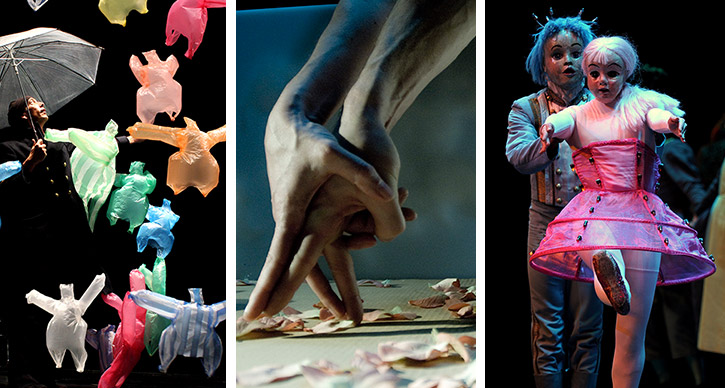
Examples of object performance abound in our 2014-2015 season. From left to right, Prelude to the Afternoon of a Foehn, Kiss & Cry, and Cinderella. Photos courtesy of the artists.
A plastic bag caught in the wind. Two hands intertwined in a miniature embrace. A doll-like mask covering a dancer’s face.
Each of these performing objects will make an appearance on a UMS stage this season.
But what exactly are “performing objects”? Are they puppets? Or something else?
In the 1980s, puppet scholar Frank Proschan defined “performing objects” as “material images of humans, animals or spirits that are created, displayed, or manipulated in narrative or dramatic performance.” By design, this is an exceedingly broad umbrella term; performing objects include but exceed traditional definitions of puppetry, which are themselves expanding. As scholar Claudia Orenstein describes it, “When we say ‘puppet’ we are no longer speaking exclusively of the figurative, crafted characters dangled from strings, gloved on hands, or attached to rods that the word had previously evoked: the Punch, Guignol, Howdy Doody, Lamb Chop, Kukla and Kermit characters of our childhoods.”
Performing objects multiply the physical, psychological and emotional possibilities of what can be done on stage. Objects have movement capacities that humans do not possess; though objects can be anthropomorphized and ascribed humanlike emotional qualities, they are often used to push the boundaries of what is acceptable or tasteful, in ways that would be more difficult for audiences to accept with a human performer.
Last season, UMS audiences saw three masterful performances of puppetry. The UK’s Blind Summit created both the series of life-size puppets representing the title character in Complicite’s Shun-kin and the pint-size Biblical imp Moses in The Table; though these puppets were very different in appearance and in the role they played in each production, all were created in the bunraku tradition from Japan, which utilizes three puppeteers to operate each puppet. Our audiences were also able to see the work of another modern puppet innovator, South Africa’s Handspring Puppet Company, in our National Theatre Live broadcast of War Horse. Their massive, startlingly beautiful and emotionally resonant horse puppets for that piece are critical to the impact of that World War I tale, which has played to great acclaim worldwide.
This season builds on those experiences and provides several rich examples of “performing objects” in Kiss & Cry, Prelude to the Afternoon of a Foehn, and Cinderella, where objects take on a degree of humanity, and human bodies and body parts are rendered as objects.
Behind the scenes with Kiss & Cry:
In Kiss & Cry hands, anatomized in close-up on projected film images, stand in for the whole person; the work’s dramatization of romantic entanglements takes on a level of revelatory strangeness while still maintaining the intimacy of genuine human contact. In Lyon Opera Ballet’s Cinderella, the traditional romance of the fairy tale and Prokofiev’s score are undercut and made humorous by the prominent use of toys on stage. Additionally, the dancers themselves are depicted as toys: faces covered in doll-like masks, they also move with the articulated stiffness of dolls.
A selection from the performance of Prelude to the Afternoon of a Foehn:
In Prelude to the Afternoon of a Foehn, everyday plastic shopping bags dance their own kind of ballet, manipulated by a single human performer and a series of electric fans. Tied to mimic the human form, reminiscent of balloon animals in a variety of bold colors, the bags beautifully illustrate Debussy’s score and complicate our notions of these objects as trash.
Performing objects mimic, illuminate, and make strange both the human form and human experience. Using a variety of materials, from the elevated to the everyday, the artists creating these works invite us to see the world in new and marvelous ways.
Have questions for Shannon? Ask them in the comments below.
Itzhak Perlman with U-Mpresident Mark Schlissel, UMS president Ken Fischer and Penny Fischer
From our 2014-2015 season opening performance, violinist Itzhak Perlman with University of Michigan president Mark Schlissel, UMS president Ken Fischer and Penny Fischer on stage at Hill Auditorium. Did you see the show? Join the audience conversation.
Meet Members of Pedrito Martinez Group
The Pedrito Martinez Group performs in Ann Arbor on March 14, 2014 as part of a unique double-bill with the trio of Cuban Pianist Alfredo Rodríguez.
In this video, get a peek at the behind-the-scenes moments of producing the group’s debut records, and learn more about each member of the group:
Interested in more? Read our interview with Cuban Pianist Alfredo Rodríguez.
Introducing New University Arts Integration Programs
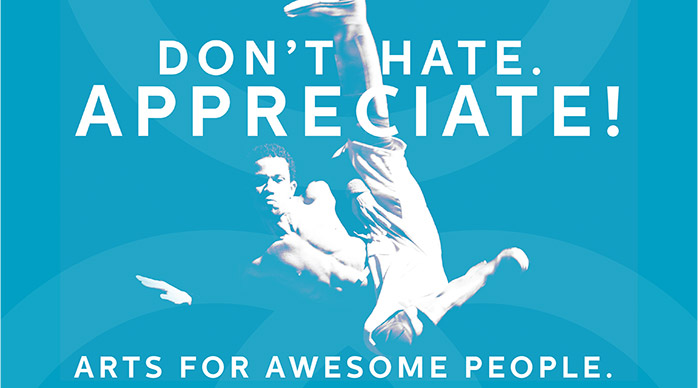
Photo: From flyer for our new “Engaging Performance” course.
UMS has long been an active partner in supporting academic excellence and innovation at the University of Michigan: we provide master classes with world-class artists for pre-professional students in the School of Music, Theatre & Dance; we’ve partnered with the Medical School to animate the Medical Arts, an innovative program to improve medical students’ bedside manner and empathic responses through exposure to the arts; and we’ve worked with dozens of individual faculty members and units on campus to link specific UMS performances to courses across the curriculum. This year, we’re building on that history of excellence to expand and strengthen the role that UMS plays in the academic life of the University of Michigan.
In 2013, UMS joined a select group of university-based arts presenters—Cal Performances at University of California at Berkeley; the Krannert Center for the Performing Arts at University of Illinois at Urbana-Champaign, and Carolina Performing Arts at University of North Carolina at Chapel Hill—in receiving multi-year grant support from the Andrew W. Mellon Foundation to further integrate of our artistic programming into the academic enterprise at our home universities.
UMS’s Education & Community Engagement department has partnered with University of Michigan’s College of Literature, Sciences & the Arts to launch a series of initiatives that will encourage the inclusion of UMS performances, and arts-based learning strategies more broadly, into the undergraduate curriculum across all disciplines. We have created a Faculty Insight Group to advise us on the latest academic trends and needs on campus; we are piloting a Faculty Institute on Arts-Academic Integration to support faculty as they create or revise courses to include the arts; and we have started a new publication for faculty, Arts in Context: UMS in the Classroom, which provides them with suggested curricular ties and informational resources for each of our performances.
The final program we’re rolling out this semester is a new course focused on the UMS season called “Engaging Performance.” Team taught by Yopie Prins from the English department in the College of Literature, Sciences, and the Arts (LSA) and Matthew Thompson from Vocal Performance in the School of Music, Theatre and Dance (SMTD), this course introduces students from all class years and academic disciplines to the wide range of performance styles and traditions that comprise our season each year. They’ll be attending seven of our performances this semester: Kronos Quartet, One Night in Bamako; Compagnie Käfig; Théâtre des Bouffes du Nord’s The Suit; Alfredo Rodríguez Trio and The Pedrito Martinez Group; Asif Ali Khan Qawwali Music of Pakistan, and Brahms’ German Requiem. Inside the classroom, they’ll be meeting with UMS staff members to learn what happens behind-the-scenes at a major arts organization; experiment with some of the art forms they see on stage in hands-on workshops with local teaching artists; and discuss the performances with many of the visiting artists involved on and backstage. Throughout the semester, they’ll be reflecting on their experiences and growth as audience members through a series of written assignments.
“Engaging Performance” students will also be interacting with you, the UMS community, here on UMS Lobby throughout the semester. They’ll be participating in the “People are Talking” discussions for the performances they attend, and we look forward to having them present with us online and in the concert hall!
What was your student experience with the performing arts? Ask questions about this program or share your experiences below.
Artist Interview: Kronos Quartet’s David Harrington
Photo: Kronos Quartet, with David Harrington on left. Photo by Jay Blakesberg.
The Kronos Quartet performs two different programs in Ann Arbor on January 17-18 2014, as part of a special week of “renegade” performances also featuring saxophonist Colin Stetson.
We called up Kronos Quartet founder and violinist David Harrington to chat about his take on renegade music, how George Crumb’s epic Black Angels (which will be performed in Ann Arbor) inspired him to found the Quartet, and his take on artists who re-define instruments as Colin Stetson does.
UMS: Your performances in January are a part of a series of renegade performances this season, as part of which we’re presenting many different artists who break the rules in their own time. How do you feel about that term “renegade”?
David Harrington: Well I like it! Suits me just fine! I’ve always thought of the string quartet as offering composers, performers, and audiences a sonic glimpse into the inner world that we all participate in, and when someone does that, when they listen to their own voice, their inner voice, dramatic things happen because it’s not necessarily the voice that the society listens to and that conventional rules conform to. And so I think that the term renegade fits our music perfectly.
UMS: Is there anything about your history that strikes you as particularly “renegade”?
Since I was a little kid I felt that the art form as a whole needed a little kick in the butt. When I was growing up and I’d go to string quartet concerts—I always sat in the front row, by the way, it’s a great place to sit—
UMS: Why do you say that?
DH: Because you can see the action, you can hear the stringiness of the sound, you can see the rosin fly, and that tactility, that horse hair meets the string, the flesh meets the wood…I love that aspect of what we do. And when I go to a concert I like to be sure I can feel as much of that as possible.
But when I was growing up and going to string quartet concerts, I was always the youngest one at the show. Always. And usually concerts started with Haydn or Mozart and then usually there’d be an intermission and then Beethoven. That’s what the art form was to the general public at that point.
The Vietnam War was raging as well, and so how does one find a voice that feels real? And in August of 1973, on the radio one night, I heard Black Angels by George Crumb. And for a moment the world made sense. And I didn’t have really any choice but I had to start a group in order to play that piece.
UMS: We actually had the chance to speak with George Crumb about Black Angels and how that piece came together.
DH: Well, it was premiered at the University of Michigan.
UMS: Yes, it was! And he actually talked a bit about the way Kronos Quartet performs Black Angels, with theatricality.
I can’t imagine what it would have been like for the Stanley Quartet to get the manuscript of that piece. I wish I could have been in the room and seen their faces when they saw that.
UMS: Funnily enough, George also spoke a bit a bit how he was actually a conductor for this piece.
DH: Yes I know! He conducted the premiere.
UMS: How did you decide to approach it the way that you do?
Well first of all, I thought about the effect that the piece had on me personally. It changed my whole life. And so for me, every time we’ve ever played it I’ve been aware of its power. And I’ve hoped, all of us in Kronos have hoped to transmit that kind of visceral potentially life-altering experience.
We’ve probably played it close to 200 times, in all kinds of settings from concert halls, churches, basketball arenas, opera houses. It’s been in a lot of places.
And it took sixteen years for Kronos to record Black Angels. So we did not record it until 1989. And I’ll tell you the reason. I felt the group needed to learn more about the recording studio and how to make the sound kind of jump off the record or the CD right into the imagination of the listener.
But even more importantly, I knew that our performance of Black Angels had to be the first track on a recording. So there’s no way you could avoid it. I was hoping that listeners would basically have to confront that piece right from the very first note that they heard. It took 16 years for me to figure out what would be the second track on the album.
UMS: And how did the theatrical aspect of the live performance come to be?
When I was growing up in the early 70s, people like Pierre Boulez were saying that the string quartet was dead. Well in August of 1973 when I heard Black Angels, I knew that he was wrong. That one piece has so much power and so much presence and it requires something not only of the players, but the listeners.
Every performance that we do of Black Angels is slightly different. We’re constantly refining the way we perform the piece, and the very first time we played it is so different from the way that we do it now that you would not even recognize it. I mean, you would recognize the music of it, but you would not recognize the visual aspect of it.
And the other thing I should say about the recording is that in the recording studio you are able to have a lot of control. We followed the timings that George Crumb wrote in the score as perfectly as we possibly could and what we noticed is that Black Angels is actually a short piece. It’s very compact. It’s also not a loud piece. It has loud moments but in general it’s a very reflective piece, with these outbursts. It just so happens that it starts with an outburst.
And so that recording influenced what we wanted to do in public performance. So we didn’t set out to create a theater piece. The piece itself is theater and we just tried to make the music come alive in the best way that we could.
UMS: Colin Stetson is performing along with you as part of a week of renegade performances at UMS. Do you know his work? What do you think of his work? What makes his work stand out for you if it does?
Well, first of all, I do know Colin Stetson’s work. I’m a huge fan. It’s not often that you encounter someone who has basically redefined an instrument. And those are the people that I like to work with. And whether it’s Astor Piazzola, or it’s Tanya Tagak, the great Inuit throat singer, or Wu Man, the great Chinese pipa virtuoso, these are people who have redefined their instrument or their approach to music. I believe that Colin Stetson belongs in the same sentence. When we were on tour in New York City, I went to hear him live, and it was an amazing experience.
Curious to know more? Read our interview with George Crumb, composer of Black Angels, or explore our listening guide to Colin Stetson.
Spotted at Sava’s: Visitor takes photo of our Propeller poster
We also can’t wait for English accents, tomfoolery & iambic pentameter. Propeller is in Ann Arbor next week, February 20-24.
Dave Holland Big Band sound checks
Dave Holland Big Band captured at sound check before their performance at the Michigan Theater on November 17.
“I wanna be like him when I’m older…”
We loved this UMS video booth video at the Gilberto Gil performance in Hill Auditorium on November 16.


